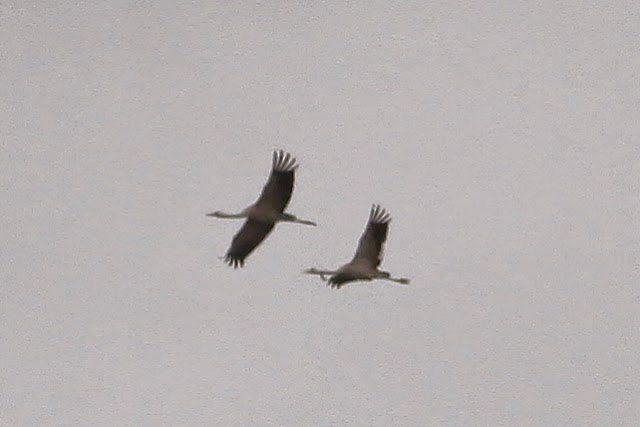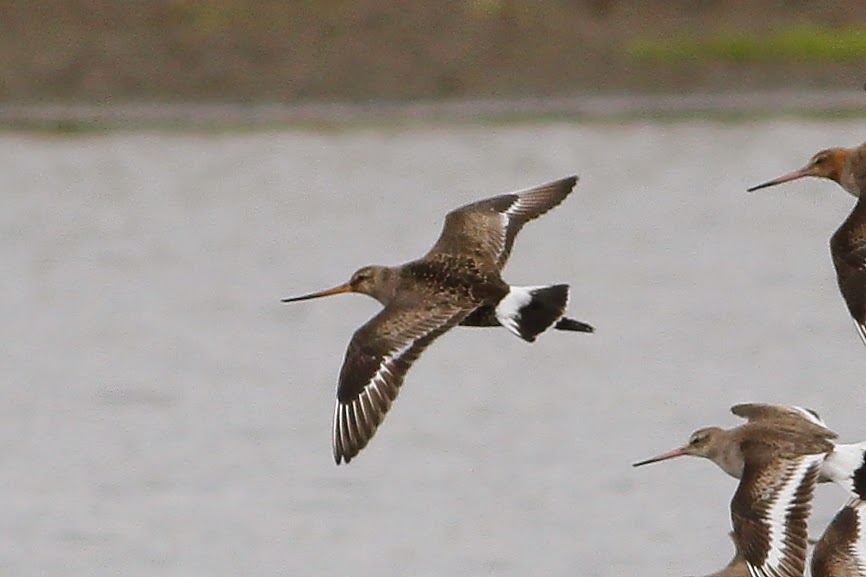When Britain's second Great Blue Heron was discovered on the Isles of Scilly on Tuesday I didn't hold out much hope of it staying until the weekend, as many spring rarities tend not to hang around. But when it was still present on Wednesday evening,
Steve Smith and I resolved to make plans to go on Saturday as long as positive news came out early on Thursday. In the end, the news was not good throughout most of Thursday until, at the very end of the day, around the time when twitchers who had spent all day failing to see the bird were still on Scillonian III and docking in Penzance, it was re-found on Bryher's Great Pool. Several would no doubt have thrown themselves overboard had they been a little further out at sea.
Bryher's Great Pool is not very great, and we had visions of the first hikers or dog walkers of the morning flushing the bird to who knows where, so we determined that if we were to go Saturday, it would have to be as early as possible. My normal preferred mode of transport to Scilly, the Scillonian, was leaving an hour late due to tides, and the thought of a long boat journey followed by a stressful island-hopping session with limited time to see the bird really didn't appeal. So we resolved to fly, and I reached for the most unloved book on my birding bookshelf: the cheque book.
 |
| The GBH: it caused a fair amount of GBH to the nervous systems of British twitchers this week |
On Thursday night the Isles of Scilly Travel Company's website, cunningly designed to prevent would-be passengers booking or paying for anything, frustrated our attempts to put a firm plan in place, so first thing Friday Steve was on the phone in a queue securing two early flights for Saturday morning. As well as not being keen on sailing over, we weren't keen on the idea of awaiting the first scheduled inter-island launch of the morning to get us to Bryher, so Steve chartered a luxury jet boat, gambling (successfully as it turned out) that we would be able to fill any spare seats with other early birders, bringing the costs down to something manageable.
So with plans confirmed, only fog could stop us now. Or perhaps high winds. Maybe mechanical failure. Not forgetting extreme tides, logistical incompetence, car breakdown, roadworks on the A30, sleeping through the alarm or having a catastrophic last minute loss of bottle. Yes, only those things could stop us now. I got a surprisingly good night's kip before Steve tapped at the door at some ungodly time, and pausing only to pick up the third member of our party, Richard Webb, who was on the same flight, thus reuniting 75% of our
Dorset birdrace team, we headed west into the night.
 |
| The Bittern-like posture adopted by the GBH in response to mobbing by Gulls |
Devon came and went, our progress through Cornwall went smoothly and we made the airport in good time. Sitting in the departure lounge, preparing to board, we found ourselves slightly disconcerted at the absence of news from the archipelago. The thought of going all that way and not seeing the bird hadn't really occurred to us until then, and moments after it was voiced I found my adrenalin and sunny optimism crash and burn in unison. But there was no going back: my camera bag was already on the conveyor belt. Then the thrill of flying - a rare indulgence for me - took my mind off it for a bit. Our captain ably landed us in the high winds which buffeted St Mary's airfield, taxis spirited us to the quayside and after a half-hour wait we were piling on to our charter with a dozen other nervous souls.
Some twitchers go to pieces at times like this, losing tripods, mobile phones, car keys etc in their single-minded pursuit of a rare bird. So, as we pulled away from the quay, it was no great surprise when one of our boarding party announced he had left his wallet in the taxi, and, abandoning his telescope, leapt back on to the quay at some personal risk to himself, ignoring the entreaties of the rest of us to retrieve it later. At least his mate was on board to look after his gear, but was unable to persuade the skipper, whose propeller was dangerously close to hitting the bottom, to wait or go back when the hapless jumper reappeared at the top of the steps waving his arms and begging to be let back on. Had a vote been taken at this point about whether or not to return, I am not sure the human spirit would have been cast in the best possible light. Fortunately, the laws of the sea are not subject to the whims of democracy, and the captain's decision being final, off we steamed in the direction of Bryher.
 |
| The Heron was imperious in flight |
As we made our way up the narrow channel between Tresco and Bryher it became apparent that we would not reach Bryher's stone quay due to the low tide. So began a comical decant mid-channel into a small motorised dinghy which beached and unloaded us on to the sand. This took two journeys, and although we were in the second, a brisk walk soon brought the original landing party back in sight a few hundred yards ahead of us. They stopped a good distance from the Great Pool, having previously agreed that whoever got there first should approach carefully, and could be seen setting up telescopes. Whether it was the high fives, air punching or back slapping I'm not sure, but something about the body language suggested that the GBH might just still be present. I quickened my pace, raised my bins and there it was: Great Blue Heron, on the far side of the pool strutting majestically among the bankside vegetation.
We watched for a few minutes from our distant vantage point, I took a few very poor record shots, and then some walkers appeared from the beach, the Heron put up and started flying straight towards us. Oh dear: we had seen it, but if it kept going, the next boatload, and the hordes who we assumed would be just getting comfortable on the Scillonian, would not. Accusations of flushing on Birdforum by the sourpuss trolls who live under its many dark bridges would surely follow. Worst of all, the pal of Man Overboard, who had been watching the GBH through Man Overboard's telescope, would have to break this news to his driver for the trip. That could be a frosty journey home, we thought.
 |
| 'It's coming right at us!' |
Fortunately, the Heron seemed to be struggling in the strong easterly wind, and after a short flight over our heads it dropped into a nearby field where it remained until we left at 1230, moving only to stretch its neck in an attempt to make itself look big and hard in response to repeated mobbing by Herring and Black-backed Gulls. It didn't have to try too much: it looked pretty big and hard as it flew over us, and was clearly more massive than our own Grey Herons. Eventually, the next boatload arrived, having yomped across Tresco and waited on the shore for the tide to drop before they could make the walk to Bryher with dry feet. Man Overboard was reunited with his scope and his nearly ex-friend, and, in that moment, all seemed well with the world.
 |
| I fumbled, and failed, to find the right exposure in the morning gloom - but photos weren't the priority: I had just seen a Great Blue Heron in Britain |




























































